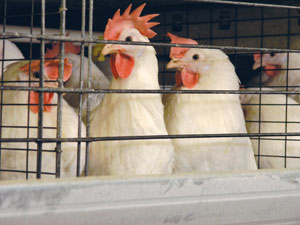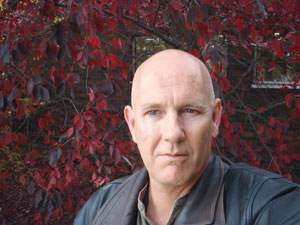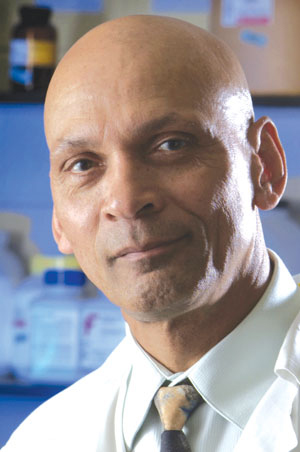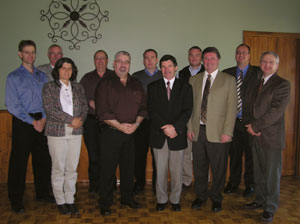
PIC update: November 08
By PIC
Features Business & Policy Consumer IssuesNon-invasive Tests of Stress in Laying Hens
Non-invasive Tests of Stress in Laying Hens
Issues of animal welfare and assurance of care are areas of growing public interest. Assessment of laying hen welfare is often based on behavioural observations or physical indications of abnormal behaviour such as feather loss due to feather pecking. It is well recognized that the assessment of animal welfare should involve, as far as possible, a comprehensive approach that includes physiological measures of biomarkers indicative of stress. Having such comprehensive assessment strategies in place can aid the industry in making objective decisions about the welfare of poultry in any given system.

|
| Dr. Nigel Cook and his team are trying to determine effective non-invasive methods to test stress in laying hens. |
A commonly used biomarker of stress in all species is the measurement of corticosteroid hormones. In avian species, the hormone measured is usually corticosterone. This is difficult to measure via blood sampling, however, since the sampling itself requires handling the birds, which stresses them. It is difficult to validate corticosterone levels in alternative sample media such as feces or eggs for the same reason, since these must be compared to circulating levels in the blood to determine if they accurately reflect circulating corticosterone levels. To date, the appropriateness of eggs and excreta to assess stress levels in birds has not been fully validated.
To overcome this problem and validate these measures, Dr. Nigel Cook at Alberta Agriculture and Rural Development, and his research team, utilized a method to collect blood without handling the birds. They inserted a catheter, which allowed for blood collection from birds that are able to move freely within their cages, undisturbed.
The first step was to determine if corticosterone levels could be captured in eggs and excreta over time. Compared to the amount of hormone in the excreta (99 per cent), very low amounts of administered corticosterone were found in the eggs (less than one per cent), suggesting measurement of stress hormones in eggs might pose technically challenging. The corticosterone was present in the feces up to at least 48 hours post-injection of corticosterone.
A second experiment was designed to compare corticosterone levels in blood, albumin, yolk and excreta. Birds were stressed by either holding them or by injecting them with a small amount of hormone that stimulates the adrenal cortex. Overall, measurements of corticosterone in the eggs and feces did not reflect the blood levels stimulated by the hormone, suggesting that these are not appropriate for use in measuring acute stress. However, the levels in the eggs and excreta closely matched overall daily adrenocortical activity, and may be appropriate for measures of long-term, chronic stress. To read more, please visit www.poultryindustrycouncil.ca.
Featured Researchers
 |
Dr. Nigel Cook did his undergraduate studies at Portsmouth University, U.K., where he majored in biology. Upon graduating in 1980, he took the position of Biomedical Scientist at the Tenovus Institute for Cancer Research, Cardiff, U.K. There he completed a PhD in 1992 entitled: “The Stressor: Response Paradigm: An Assessment by Salivary Steroid Analysis.” This was a study of the stress responses of humans and the relationship of stress to disease states.
He then moved to Canada and took the position of Research Scientist with Agriculture and Agri-food Canada studying stress responses of livestock, and in 2002 became Research Scientist in livestock welfare with Alberta Agriculture, where he remains.
 |
Dr. Cook’s research interests are in the discovery, development and application of biomarkers of stress, pain and disease in livestock species. The research program focuses on minimally invasive sampling methods and the analysis of stress-related hormones, e.g., cortisol and corticosterone. Also, the proteomic profiling of blood and saliva samples for the identification of protein and polypeptide mass profiles that may be indicative of disease, stress and pain.
Carlton Gyles is Professor emeritus in the Department of Pathobiology, University of Guelph. He is a 1964 graduate of the Ontario veterinary College who has conducted research on E. coli in poultry, pigs, cattle and humans over the past 40 years.
|
A new approach to immunization against
E. coli infections in broilers Carlton Gyles, University of Guelph Avian pathogenic E. coli (APEC) are common in barn dust. Following inhalation by chickens, the bacteria are often eliminated by the clearance mechanisms of the respiratory system. However, in the presence of other immune challenges caused by viruses, Mycoplasma, ammonia, or dust, APEC can establish in the respiratory system and disseminate throughout the body. This results in respiratory/septicemic disease. This diseaae occurs commonly in two- to four-week-old broilers and is a leading cause of economic loss. A vaccine against APEC would provide industry with a tool to manage this problem, improving both animal health and profitability. Dr. Carlton Gyles and graduate student Haitham Ghunaim at the University of Guelph have been investigating four different antigens for their ability to induce protection in broilers against E. coli respiratory/septicemic disease. The researchers injected the antigens into broilers and collected serum containing the antibodies produced in response. When the antibodies were injected into broiler chickens it was found that antibodies against three of the four antigens tested protected the birds from APEC respiratory challenge. They then tested the three successful antigens further by two methods: i) vaccinating broiler breeders and assessing their chicks for protection after challenge with APEC, and ii) vaccinating broiler chicks and later challenging them with APEC. Their findings? Vaccinating the broilers breeders did not lead to a protective effect for their chicks in this study. For the directly vaccinated chicks, one antigen (PapG) was effective in eliciting protective antibodies against E. coli. This finding indicates that PapG is a promising vaccine candidate for a vaccine against respiratory/septicemic disease due to E. coli in broilers. |
PIC Pic's
Golf Day
Did you make it to the golf tournament? It was a great event with more than 200 players, a beautiful day and fabulous prizes. If you’re thinking about playing with us next year, don’t wait too long to book because next year we don’t clash with Poultry Day at the Outdoor Farm Show so we expect to be sold out (and we can’t book a bigger course). The tournament will be held on Wednesday, Sept. 9, 2009, so book now.
Our annual meeting took place on Oct. 7 and went well. The meeting was preceded by an update of our research endeavours for the year. About 40 people turned up and gave some terrific feedback on how we can improve what we’re doing at PIC to make it more relevant to you and more powerful in terms of tackling some pressing industry issues.
Funding
This year the PIC has more than $2 million worth of new projects under management. More than half of that money is coming from external (to industry) investors: the Agricultural Adaptation Council and the Ontario Ministry of Agriculture, Food, and Rural Affairs (OMAFRA). Between them, these investors are contributing over $1 million – many thanks to them. This external funding is a major bonus to industry and when we calculate the income from other provinces and institutions we are now receiving $6.40 for every $1 invested by Ontario producers and industry.
 |
Board Members
At the annual meeting retiring members were re-elected. We welcome back Stephen Halley (Intervet – Schering-Plough), Mike Terpstra (RBC), Charlie Elliott (Masterfeeds) and Brian Baynton (Alltech) as board members. These guys do a great job of keeping the PIC working on delivering research and education for industry – for absolutely no reward. Many thanks to all of them and the other members Rick Bennet (KL Products), Helen Anne Hudson (Burnbrae Farms), Ed McKinlay (McKinlay Farm) and Kevin Weeden (Weeden Environments) and to the feather board representatives for the coming year: George Campbell (TFO), Bob Guy (OBHECC), Vic Slobodian (EFO) and Murray Opsteen (CFO).
Thompson Steps Down
We said goodbye to Kevin Thompson, who has served on the PIC board for a number of years and helped steer PIC through some turbulent times – thanks for your valuable input, Kevin.
Research Facilities
This month, discussions about the new research facilities at Elora (the Guelph 2050 initiative), get underway between Industry, OMAFRA and U of G – watch this column for updates.
Print this page